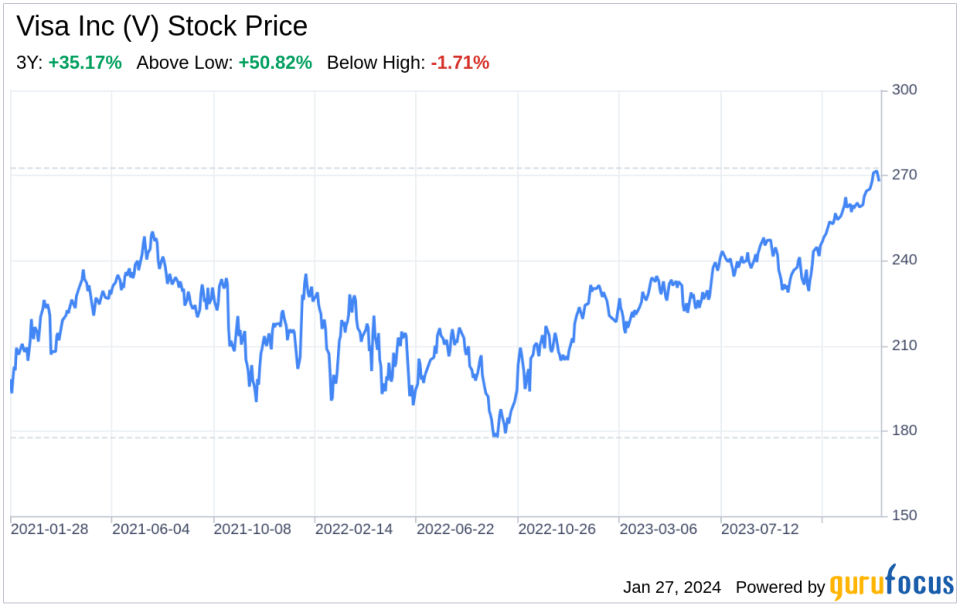-
Visa Inc showcases robust financial growth with net income rising to $4,890 million in Q1 2024.
-
Operating income surged to $5,954 million, reflecting Visa’s operational efficiency and market dominance.
-
Comprehensive income reached $5,552 million, indicating strong overall financial health.
-
Visa’s strategic acquisitions and investments position it for continued innovation and market expansion.
On January 26, 2024, Visa Inc, the world’s preeminent payment processor, disclosed its first-quarter financial results via a 10-Q filing with the SEC. The company continues to demonstrate its financial prowess, with net revenues climbing to $8,634 million, up from $7,936 million in the same period last year. This growth is underpinned by a significant increase in net income, which rose to $4,890 million from $4,179 million, and an operating income jump to $5,954 million from $5,090 million. Visa’s comprehensive income also saw a healthy increase to $5,552 million. These figures underscore Visa’s robust financial position and its ability to generate shareholder value. The company’s strategic acquisitions, such as the purchase of Pismo Holdings, signal a commitment to innovation and market expansion. As we delve into a SWOT analysis, these financial highlights will serve as a backdrop to understand Visa Inc’s strategic position in the market.

Strengths
Market Leadership and Brand Value: Visa Inc’s dominant position in the global payments industry is one of its most formidable strengths. With a processing capability of over 65,000 transactions per second and operations in over 200 countries, Visa’s brand is synonymous with reliability and security in electronic payments. The company’s latest financial results, with net revenues of $8,634 million and a net income of $4,890 million, reflect its strong market presence and operational excellence. Visa’s brand value not only attracts customers but also instills trust among its financial institution partners, merchants, and government entities.
Technological Infrastructure: Visa’s technological infrastructure, VisaNet, is a cornerstone of its strength. It supports the vast volume of transactions processed by the company, showcasing both scalability and resilience. The recent acquisition of Pismo Holdings, a cloud-native issuer processing and core banking platform, for $1.0 billion, demonstrates Visa’s commitment to maintaining its technological edge. This acquisition is poised to enhance Visa’s digital offerings and expand its capabilities in the rapidly evolving fintech space.
Financial Health: Visa’s financial health is robust, as evidenced by its strong balance sheet and impressive earnings performance. The company’s basic earnings per share (EPS) for Class A common stock increased from $1.99 to $2.39 year-over-year, signaling healthy profitability. Furthermore, Visa’s comprehensive income of $5,552 million, up from $5,289 million in the previous year, indicates solid financial stability and the ability to invest in growth opportunities.
Weaknesses
Dependence on Consumer Spending: Visa’s revenue is heavily reliant on consumer spending and the volume of transactions processed. While this has been a boon in times of economic prosperity, it also exposes the company to market downturns and shifts in consumer behavior. Economic uncertainties, such as inflation or recessionary pressures, could lead to reduced spending and impact Visa’s revenue streams.
Regulatory Challenges: Visa operates in a highly regulated industry, and changes in regulations or compliance requirements can pose significant challenges. The company’s ongoing legal matters, including various antitrust proceedings and litigation related to interchange fees, highlight the potential financial and reputational risks associated with regulatory scrutiny.
Competition and Market Saturation: The payment processing industry is becoming increasingly competitive, with new entrants offering innovative payment solutions. Visa’s market leadership position could be challenged by these emerging players, especially in markets that are nearing saturation. To maintain its competitive edge, Visa must continue to innovate and adapt to changing market dynamics.
Opportunities
Expansion into Emerging Markets: Visa has significant opportunities to grow its footprint in emerging markets, where electronic payment adoption is still in its infancy. By leveraging its global brand and technological capabilities, Visa can tap into new customer segments and drive transaction volume growth.
Digital Payment Innovation: The shift towards digital payments presents a substantial opportunity for Visa. The company’s investment in Pismo Holdings aligns with the trend of cloud-based financial services and positions Visa to capitalize on the growing demand for digital and mobile payment solutions.
Strategic Partnerships: Visa’s ability to forge strategic partnerships with financial institutions, technology companies, and merchants can create new revenue streams and enhance its service offerings. Collaborations that leverage Visa’s payment network can lead to the development of innovative products and services, further solidifying its market position.
Threats
Technological Disruptions: The rapid pace of technological innovation in the payments industry poses a threat to Visa’s business model. Disruptive technologies, such as blockchain and cryptocurrencies, could potentially bypass traditional payment networks, impacting Visa’s transaction volumes and fee structures.
Geopolitical Tensions: Visa’s global operations expose it to geopolitical risks, including trade disputes and sanctions. These tensions can disrupt cross-border transactions and affect the company’s international business.
Data Security Concerns: As a payment processor, Visa is a target for cyber threats and data breaches. Any significant security incident could undermine consumer trust, result in substantial financial losses, and lead to increased regulatory scrutiny.
In conclusion, Visa Inc’s latest 10-Q filing reveals a company with a strong financial foundation, marked by
This article, generated by GuruFocus, is designed to provide general insights and is not tailored financial advice. Our commentary is rooted in historical data and analyst projections, utilizing an impartial methodology, and is not intended to serve as specific investment guidance. It does not formulate a recommendation to purchase or divest any stock and does not consider individual investment objectives or financial circumstances. Our objective is to deliver long-term, fundamental data-driven analysis. Be aware that our analysis might not incorporate the most recent, price-sensitive company announcements or qualitative information. GuruFocus holds no position in the stocks mentioned herein.
This article first appeared on GuruFocus.







